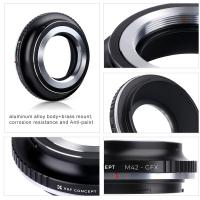What Is The Magnification Of A Microscope ?
The magnification of a microscope refers to the degree to which an object appears larger when viewed through the microscope. It is typically expressed as a ratio, such as 10x or 100x, which indicates how many times larger the object appears compared to its actual size. Magnification is achieved through a combination of lenses and other optical components in the microscope, which work together to focus and enlarge the image of the object being viewed. Different types of microscopes may have different magnification ranges, depending on their design and intended use.
1、 Optical magnification
What is the magnification of a microscope? The magnification of a microscope refers to the degree to which an object is enlarged when viewed through the microscope. There are different types of magnification, including optical magnification, which is the most common type used in microscopes.
Optical magnification is the ratio of the size of the image produced by the microscope to the size of the object being viewed. For example, if an object is viewed through a microscope with an optical magnification of 10x, the image produced will be 10 times larger than the actual size of the object.
However, it is important to note that magnification alone does not provide a complete picture of the object being viewed. Other factors such as resolution, contrast, and depth of field also play a crucial role in the quality of the image produced.
In recent years, there has been a growing interest in the use of digital microscopes, which use digital imaging technology to produce high-resolution images of objects. These microscopes offer a range of benefits, including the ability to capture and store images for later analysis, as well as the ability to share images with others remotely.
Overall, the magnification of a microscope is an important factor to consider when choosing a microscope for a particular application. However, it is important to also consider other factors such as resolution, contrast, and depth of field to ensure that the microscope is capable of producing high-quality images that meet the needs of the user.

2、 Total magnification
"What is the magnification of a microscope?" is a common question asked by students and researchers alike. The magnification of a microscope refers to the degree to which an object is enlarged when viewed through the microscope. It is a crucial factor in determining the level of detail that can be observed and studied.
The magnification of a microscope is determined by two factors: the magnification of the objective lens and the magnification of the eyepiece. The objective lens is the lens closest to the object being viewed, while the eyepiece is the lens closest to the eye of the observer. The magnification of the objective lens is typically marked on the lens itself, while the magnification of the eyepiece is usually 10x.
To calculate the total magnification of a microscope, you simply multiply the magnification of the objective lens by the magnification of the eyepiece. For example, if the objective lens has a magnification of 40x and the eyepiece has a magnification of 10x, the total magnification of the microscope would be 400x.
It is important to note that while magnification is a crucial factor in microscopy, it is not the only factor that determines the level of detail that can be observed. Other factors, such as resolution and contrast, also play a significant role in determining the quality of the image produced by a microscope.
In recent years, advances in technology have led to the development of new types of microscopes with higher magnification capabilities. For example, electron microscopes can achieve magnifications of up to 10 million times, allowing for the observation of structures at the molecular level. These new technologies have opened up new avenues of research and discovery in fields such as biology, chemistry, and materials science.

3、 Numerical aperture
"What is the magnification of a microscope?" and "Numerical aperture" are two different concepts related to microscopy. The magnification of a microscope refers to the degree to which an object appears larger when viewed through the microscope. It is determined by the combination of the objective lens and the eyepiece lens. The magnification of a microscope can range from 40x to 2000x or more, depending on the type of microscope and the lenses used.
On the other hand, numerical aperture (NA) is a measure of the ability of an objective lens to gather and focus light. It is determined by the refractive index of the medium between the lens and the specimen, and the angle of the cone of light that enters the lens. A higher numerical aperture means that the lens can gather more light and produce a sharper image with greater resolution.
In recent years, there has been a growing interest in using numerical aperture as a way to improve the resolution of microscopes beyond the limits imposed by the diffraction of light. This has led to the development of super-resolution microscopy techniques such as structured illumination microscopy (SIM), stimulated emission depletion microscopy (STED), and single-molecule localization microscopy (SMLM). These techniques rely on the use of high numerical aperture lenses and sophisticated image processing algorithms to achieve resolutions that are beyond the diffraction limit.
In conclusion, while the magnification of a microscope is important for visualizing small objects, numerical aperture is critical for achieving high-resolution images. The use of high numerical aperture lenses and super-resolution microscopy techniques has revolutionized the field of microscopy and opened up new avenues for studying biological systems at the nanoscale.

4、 Resolution
"What is the magnification of a microscope?" is a common question asked by those who are new to microscopy. Magnification refers to the ability of a microscope to enlarge an object, making it appear larger than its actual size. The magnification of a microscope is determined by the combination of lenses used in the instrument. The magnification of a microscope can range from a few times to several thousand times.
However, it is important to note that magnification alone does not determine the quality of the image produced by a microscope. Resolution is another important factor that determines the clarity and detail of the image produced by a microscope. Resolution refers to the ability of a microscope to distinguish between two closely spaced objects as separate entities. The higher the resolution of a microscope, the clearer and more detailed the image produced.
In recent years, there have been significant advancements in microscopy technology, leading to the development of high-resolution microscopes such as super-resolution microscopy and electron microscopy. These advanced microscopes have revolutionized the field of microscopy, allowing scientists to study biological structures and processes at the molecular level.
In conclusion, while magnification is an important factor in microscopy, resolution is equally important in determining the quality of the image produced. With the latest advancements in microscopy technology, scientists can now study biological structures and processes with unprecedented detail and clarity.







































